those about to die
| série: | Histoire (Rome) |
| éditeur: | Panther |
| auteur: | Mannix Daniel |
| classement: | biblio2 |
| année: | 1966 |
| format: | broché |
| état: | TBE |
| valeur: | 6 € |
| critère: | ** |
| remarques: | those about to die 1/ the first major circus intended to run chariot races (quadriga) n.b. quadrige = char à deux roues attelé de quatre chevaux de front, les deux chevaux du milieu étaient séparés par un court timon, les deux autres n'étaient attelés que par des traits de corde - the Roman games (ludi) for which the Roman working-class was subsidized and was sacrificing their standard of living for a life of ease (bread and circuses), in the circus alone are the people rulers - the chariot races which were the most popular game, were mostly held in the circus Maximus (641 m long, 120 m wide) which could contain up to 350'000 persons, the spine was the show spot of the whole circus - the chariots had to circle the spine seven times (about 6 km), the chariot's racing was managed by corporations, the main four ones being: the white, the red, the green and the blue - the races were hard and deadly, every driver trying to reach the inside track round the spine - most famous charioteers: Diocles, Eutychus and Crescens - the best horses in a race were called "centenarii", there were also famous horses, such as Passerinus and of course Incitatus (Caligula's favourite horse) - the chariot race had a name: hippomania, eventually the games come to cost 1/3 of the total income of the empire >> some description of the games were written by: - Marcus Martialis (in the Epigrammes) - Lucius Apuleius - Decimus Juvenal (in book XI: le luxe de la table, panem et circenses) - Suetonius and Tacitus 2/ the gladiatorial combats - the gladiators (swordsmen, ludus gladiatorus) entered the circus with the advise: "ave Caesar, morituri te salutant" - they were armed traditionnally with: sword (gladius), shield (scutum), helmet (galea) and protective sleeve (manica) kind of fighters: - Secutor or Myrmillo (chaser) with sword, helmet and shield - Thracian with small round shield and curved sword - Retiarus (netman) with net and trident (usually three-pronged) - the Samnite was the prototype of the gladiator - Bestiarus, fighting against animals - Essedanus, fighting from a chariot - Sagittarius, armed with bow and arrow - Dinachaerus, armed with two swords - Hoplomachus, heavily-armed gladiator there were four main gladiatorial schools in Italy under Augustus: - the Great school - the Gallic school - the Dacian school - the school for Bestiarii - gladiators were led by "lanistae" (trainers) and had usually to fight for 3 years; to be given a wooden sword meant to the gladiator that he could retire from the arena - the boxing fights with the "caestrus" (a brass knuckle) - under Julius Caesar, gladiator games became a national institution, Marcus Aurelius was one of the best emperors Rome ever had but as a result of his contempt for the games, he was also one of the most unpopular - famous gladiators: Flamma, Statius and of course Spartacus - habet, hoc habet (he's had it) said by the spectators when a gladiator has been practically knocked down 3/ novelties in the games - naumachia or naval combats, originated by Julius Caesar, opposed triremes on a lake created in the circus 4/ circus buildings - the first century of the Christian era probably marked the high point of the games, they were played mostly at the circus Maximus which could held up to 350'000 people being a quarter of Rome's population a that time - Vespasian, 70 AD, started the construction of the Colosseum which was finalized by his son Titus, it was the best amphitheatre ever built by Romans, it was equipped with a system of elevators, had 80 entrances and two main doors: the Gate of Life and the Gate of Death opening directly into the arena, one circular drain was connected to the Cloaca Maxima, Rome's main severage system - there was also, supported by tall masts, a great awning which covered the top of the Colosseum to protect the audience from sun and rain, there was also an underground world (just under the stands) - to protect the audience from the wild animals, it must have be, inside the amphitheatre, an inner wall of heavy wooden planks running round the arena, these planks could be painted and used as a scenery - the stands were divided horizontally by flat walks (praecinctiones) and vertically by stairs (cunei) - the main circuses of Rome were: the Colosseum (being a complete oval), the circus Maximus, the circus Hadrian, circus Flaminus, circus Maxentius and circus Castrense (for the Praetorian Guard) - further circuses were built at Capus, Pompeii and Verona in Italy, at Arles and Nîmes in France, in Seville in Spain, in Antioch in Asia Minor, at Alexandria in Egypt and at Silchester in Britain - the games had to be run on a very tight schedule >> p. 49/50 description and organisation of the games but in fact it was the mob who ran the circus and dictated the games 5/ wild animal shows - the training of animals (such as lions) to become man-eaters (see p. 55/56) - sexual relations between a woman and an animal were often exhibited; the training of animals to rape women (by the odour), usually done by jackasses (male donkeys) or large dogs - Carpophorus was one of the most famous bestiarii (as a venator = hunter) 6/ a day at the Colosseum - the location to the seats are organized by the locarii (ushers = guide), perfumed fountains shoot coloured water into the air to cool the vast circus, the arena floor is covered with white sand - also programmes, cool drinks, sweetmeats and cushions were sold during the performances >> p. 61-64 the atmosphere and the crowd before the games - the andabatae = gladiators wearing helmets without a visor so they could not see - the ringmaster = master of the games was responsible for arranging the development of the games 7/ nautic games - organized lakes, artificial mountains with trees, flowers and even with streams of running water were set up - fights with crocodiles and hippos were also organized 8/ persecutions - of Jewish prisoners and of Christians 9/ gladiators' fights - with the time, it became more and more difficult to find and train professional gladiators and the demand for good fighters could no longer be complied with, for that reason, the circus fights become slowly as phony as a modern wrestling match n.b. phoney = fake >> p. 101-104 - fight between hoplites using their strong phalanx and Essedarii using light, two-horse chariots - the Leuctrain wedge (triangle of hoplites) - the trick of the lasso (loop rope) used by Essedarii >> p. 106-108 - combat with the elephants and their mahouts against the Numidians and the Samnites, the Romans liked the elephants but the legionnaires were first frightened by them in the battles, each war elephant had his own special technique for killing their opponents - the Paegniarii with wooden shields and long bullwhips, the Hoplites in full armour, the Myrmillones with curved scimitars and the Retiarii with net and trident were the most popular gladiators 10/ gladiators' pastime - Chilo's wineshop where the different professions attached to the circus met and discussed, sometimes with rude manners 11/ sea and other battles -nautical games in the arena flooded with salt water and filled with sea monsters such as sharks - fights against bulls (aurochs and bisons) >> p. 114 discussion about bullfights >> p. 118 the fighting dogs - individual fights between gladiators, engagement between companies of gladiators, between Equestres = mounted men on horseback and Hoplomachi = heavily armoured cavalry men n.b. the Romans at the beginning made little use of their cavalry during battles, putting their faith more in the legions manoeuvring on foot 12/ variations in the games - Marcus Aurelius, the great Roman emperor and philosopher said about ghe games: " I would not mind the games being brutal and degrading if only they were not so damned monotonous" - nevertheless, the Romans had also a good sense of humour and animals were also trained to be acrobats and artists >> p. 128 the breeding of unicorns (like a rhino) >> p. 129 the famous story of Androcles and the lion >> p. 131 the fictional death of Carpophorus 13/ the collecting of wild animals - this activity was at that time an enormous industry, statistics and documents (mostly from mosaics and frescos) about the capture of wild animals show how vital this was to the Romans - the shipping of the animals was the most difficult part >> p. 137 the Roman fort discovered near Mombasa where some Roman coins were found 14/ conclusions - at the beginning of the games, there was still some sense of fair-play, e.g. an animal had a good chance to defeat his human opponent, but gradually the games degenerated into spectacles of pointless massacres - actually a good fight between gladiators could last for hours but the mob wanted fast and bloody action - also every emperor had to outdo his predecessors and the games went mostly corrupt and full of sadism and finally became a farce! - the costs grew gigantic and still the work labour made by the slaves were not counted in, however even Tacitus and Pline were in favour of the games, only Seneca protested against them - the Christian persecutions offered the ideal victims for the games, first under Nero, the most terrible persecutions took place under Marcus Aurelius (166 AD), he was intelligent and enlightened but despised the Christians >> description of the persecutions by Felix and Verus Macarius as well as by Suetonius - the games ended about 400 AD by lack of gladiators and lack of money and also as the Roman empire was now invaded by the barbarians - the best remaining circuses apart of the Colosseum are in Verona and in Nîmes, the best preserved in Pompeii - the games were a vital and integral part of Roman life and psychology, from athletic contests they however developed into bloody ruthless fights >> a good book but somehow written in a poor style, however much detailed despite the fact that the truthfulness of the details cannot always be confirmed Bibliography Ancient: - Apuleius, extraits; Eusebius, historia ecclesiastica; Diocles, mémoires; Juvenal, luxe de la table; Macarius, description of the games; Martialis, the spectacles; Pline le Jeune, lettres; Seneca (Sénèque), lettres, Suetonius, vie des 12 césars; Statius, trebaid, Tacitus, histoires Modern: - Roland Auguet (1972): the Roman games - Arthur Koestler: the gladiators - Bernard Shaw: Androcles and the lion - Lew Wallace: Ben Hur - Henryk Sienkiewicz: Quo Vadis |
| couvertures: | 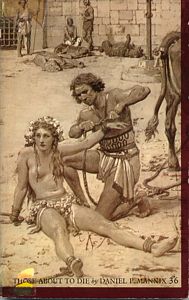 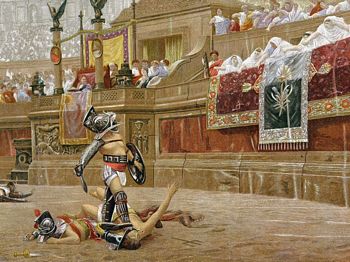 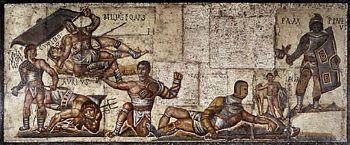 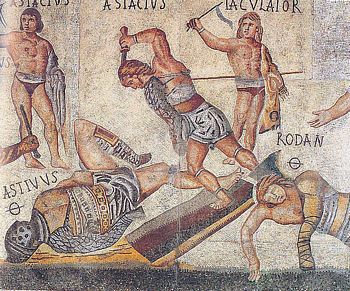 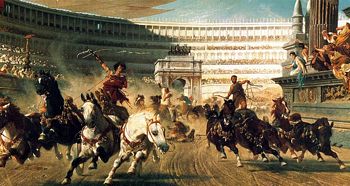 |
Copyright 2008 - 2025 G. Rudolf
